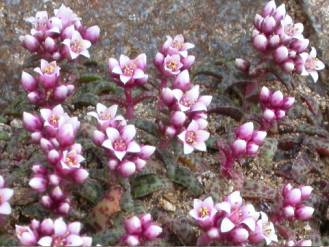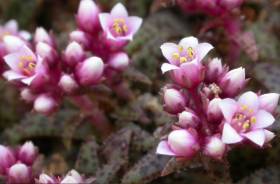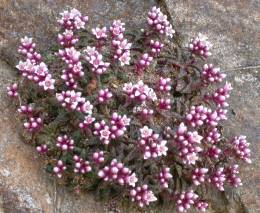Crassula exilis
Crassula exilis Harv.
Family: Crassulaceae
Common names: None recorded
Introduction
An attractive, dwarf succulent flowering cushion, excellent for rockeries and living walls.

Description
Description
Crassula exilis grows naturally as a dense mat, forming cushions usually in crevices and soil pockets on vertical or steep rock faces. The leaves are variable in size and appearance but are typically 4-45 mm long and 3-10 mm wide, often with a convex upper leaf surface, and tapering towards a point. They usually have fine hairs along the margin. The colour is usually grey-green with dark irregularly placed dimpled spots on the upper surface. The plant is highly branched giving rise to the dense leafy mats.

Flowers appear in late summer through to late autumn. They are small and cup-shaped with petal tips spreading from midway up the corolla tube, usually 3 mm in diameter, and white to more or less pink, with a musty honey-like fragrance. They cluster to form a dense inflorescence which can be up to 100 mm high. The root system is adventitious. Flowers develop into small capsules which release fine dust-like seed.
There are four recognized subspecies: C. exilis subsp. exilis, subsp. cooperi, subsp. picturata, and subsp. sedifolia.
Conservation Status
Status
Crassula exilis subsp. exilis is considered rare in the 2009 Red Data listing (Raimondo et al. 2009). The other subspecies have no threat status.
Distribution and habitat
Distribution description
The distribution area stretches from the most westerly populations of C. exilis subsp. exilis in the Northern Cape and C. exilis subsp. sedifolia also in the Northern Cape and southern Namibia to C. exilis subsp. cooperi in the Eastern Cape from Graaff-Reinet to Aliwal North.
Derivation of name and historical aspects
History
Crassula in Latin means 'the little fat one'; exilis, also Latin, means 'small, delicate, meager and of weak appearance'.
Ecology
Ecology
Plants are usually found in rock crevices or shallow soil pockets in protected moist and shaded places on steep or vertical rock faces. They are recognized as obligate cliff dwellers, meaning that they live exclusively on rock faces and never on flat open soil. This is an effective anti-herbivory mechanism. The geology on which they occur is varied and includes sandstones, granites and shales.
Uses
Use
There are no known uses for this plant.

Growing Crassula exilis
Grow
Crassulas are amongst the easiest plants to cultivate and this species is no exception. They can grow in virtually any type of soil but prefer a mixture of half gritty sand and half fine compost. They can grow in light shade or in sunny positions and make excellent cushion plants for rockeries or living walls. They are not demanding in regard to water but will grow faster under moister conditions. Watering should take place at least once a week but they will survive with less.
Propagation is easy from cuttings, including leaf cuttings, at any time of the year which means they can be bulked up very easily. Cuttings can be tiny and only need to have a short section of stem with a few nodes and a few leaves. Insert them into a dry gritty growing medium and water them lightly. Keep the pot in a bright situation but out of direct sunlight at first. Rooting should take place within 2 weeks. Once the plants have visibly beefed up, move them to a sunny spot, and before long young plantlets will form, forming small rosettes which will rapidly become dense cushions.
If one could ever acquire seed, this could be sown in spring. Mix the dust-like seed with a small quantity of fine sand. Spread the sand evenly over the surface of the soil which should be the same as the growing medium. Water immediately, preferably from below by standing the pot in a tray of water every few days. Keep the soil moist like this for the first month or so. Before long, tiny green plantlets should appear on the soil surface. Start to let the soil dry out between waterings. Soon the plants will bulk up and if one achieves the ideal growing conditions, one can raise many thousands of plants like this. The use of a damping-off fungicide is advisable.
Occasionally they suffer from fungal infections which appear as brown blotches on their leaves. This can be treated with a fungicide and good ventilation. Otherwise, they are essentially pest free.
Plants can live for many years in pots or in a rockery and will grow to occupy the available space. They are quite spectacular at flowering time when planted en masse. If conditions are right they will seed themselves and replenish themselves naturally. Like many of the closely related Sedum species in Europe, this species is also particularly well suited for use in establishing an artificial living wall. Plants do not require much water and are resilient during dry spells. They also grow in full sun and full shade making them very versatile plants. They also provide the added bonus that they shed their old inflorescences quite quickly after flowering, keeping the plant looking neat and tidy.
References
- Raimondo, D., Von Staden, L., Foden, W., Victor, J.E., Helme, N.A., Turner, R.C., Kamundi, D.A. & Manyama, P.A. (eds) 2009. Red List of South African plants. Strelitzia 25.South African National Biodiversity Institute, Pretoria.
- Rowley, G. 2003. Crassula, A grower's guide. Cactus & Co. libri.
- Tölken, H. R. 1985. Crassulaceae. Flora ofsouthern Africa. 14. Botanical Research Institute, Pretoria
Credits
Adam Harrower
Kirstenbosch National Botanical Garden
December 2010
Plant Attributes:
Plant Type: Succulent
SA Distribution: Eastern Cape, Northern Cape
Soil type: Sandy, Loam
Flowering season: Late Summer, Autumn
PH: Acid, Neutral
Flower colour: White, Pink
Aspect: Full Sun, Shade, Morning Sun (Semi Shade), Afternoon Sun (Semi Shade)
Gardening skill: Easy
Special Features:
Horticultural zones











Rate this article
Article well written and informative
Rate this plant
Is this an interesting plant?
Login to add your Comment
Back to topNot registered yet? Click here to register.